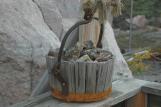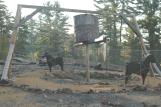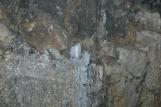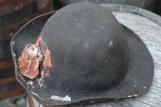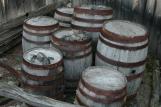1
Tools and techniques used by early copper miners.1847
Simpson Mine Shaft, Bruce Mines, Ontario, Canada
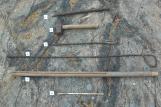
2
The basic tools used by the early miners were a borer, hammer, gad (wedge), pick and shovel. The miners would start using a hand borer (1) and hammer (2). The hand borer would be turned a quarter turn after each hammer strike. Rock chips were removed from the hole with a long handled "spoon" (3), or scraper. Miners would change the short borers for longer ones as the hole became deeper. A long, thin steel rod (4), also called a needle or nail, was inserted into the hole, and then black powder, a mix of charcoal, potassium nitrate, and sulphur, was carefully tamped around the rod with a wooden tool (5) called a tamping bar. This would have to be done carefully, as any spark off of the steel rod could result in an explosion. Eventually the steel rod would be redeveloped and replaced with a thin rod constructed of copper to prevent the chance of sparking. They would then remove the wooden tool and the thin steel rod, leaving a hole running down through the center of the black powder. A fuse would then be threaded into the hole in the center of the black powder. In the mid 1800's regular string or safety fuse was being developed and was probably the type of fuse that was used in the Bruce Mines, rather than the goose quills (6), which had been used in earlier Cornish mines. While there were no known deaths in the mines caused by these powder explosions, there are reports of injuries."…two of his men had just been injured by a premature explosion.
…They were dreadfully burnt and torn about the face, and were moaning with pain, and still more at the thoughts of losing their eyes…"
Louis Agassiz, 1848
4
There would be a preliminary sort in the mine, separating wall rock and ore rock. The ore would be placed in the kibble buckets in the mine and hoisted to the surface through the headframe, and dumped by a miner, referred to as the "lander".5
Buck O'Donnell sketch of 'The Windlass' from 'The Old Timers' collection on Cornish miners.1966
Bruce Mines, Ontario, Canada
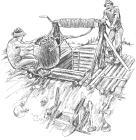
6
The methods used to hoist the kibble buckets to the surface were by manpowered windlass, or after the shaft became too deep, a horse powered "whim".8
In 1846 and 1847 steam engines were being used in England but had not yet been introduced to the Bruce Mines area.The Simpson Mine Shaft contains a reconstructed whim. Ropes are wound around a large drum, then over several pulleys to hang down through the head frame into the shaft. The horses would walk around in a circle, lowering an empty bucket while simultaneously raising a full bucket. When the full bucket reached the surface, the horses were stopped, and the "lander" would dump the bucket. After the bucket was emptied, the horses then went in the opposite direction, lowering the empty bucket while bringing up another full one. This routine continued throughout the day.
